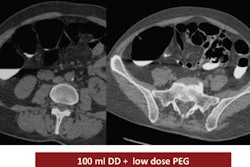In the history of medical imaging turf wars, the primary battlegrounds have been in modalities such as echocardiography, musculoskeletal MRI, and nuclear cardiology. You can now add CT to the list, according to a new study that indicates CT procedure volume is spiking among nonradiologists.
Dr. David Levin and colleagues at Thomas Jefferson University Hospital in Philadelphia examined nationwide trends in the ownership and leasing of CT scanners in private offices by nonradiologist physicians, using Medicare Part B claims databases for 2001 through 2006 (Journal of the American College of Radiology, December 2008, Vol. 5:12, pp. 1206-1209).
In introducing the study, Levin and colleagues note that the prospect of additional revenue from imaging studies has prompted many nonradiologists to purchase or lease advanced imaging equipment such as MRI, CT, or PET scanners. They are able to do so legally under the in-office ancillary services exception to the Stark anti-self-referral laws.
Because the study focused on who owned or leased the CT equipment, the team included all technical component and global claims from private-office settings, but did not include professional component claims. The group also did not include claims that originated from hospitals, because physicians rarely own CT scanners that are located in hospitals.
The researchers focused on procedure volume generated by CT scanners owned or used by medical specialists (including radiologists), rather than the actual number of CT scanners owned or leased by physicians.
The team found that between 2001 and 2006, CT procedure volume in radiologists' private offices increased by 85%. But among nonradiologists, the increase was 263%, and among independent diagnostic testing facilities (IDTFs), the increase was 231%.
Volume of Medicare CT exams performed or leased in private offices or imaging centers, by specialty owning or leasing the facility, 2001 to 2006
|
||||||||||||||||||||
| Tables courtesy of the Journal of the American College of Radiology. |
Among nonradiologists, primary care physicians performed the greatest number of CT scans on units they owned or leased in 2006, with a growth rate of 215% over the five-year span. Internal medicine specialists reported the next highest utilization growth rate, followed by urologists and cardiologists.
Top 10 nonradiologic specialties performing CT exams on private-office equipment they owned or leased, Medicare, 2001 to 2006
|
In 2001, among all Medicare CT scans performed on units owned or leased by physicians in private offices (not including IDTFs), the market share for nonradiologists was 16%. By 2006, their market share had almost doubled to 28%.
Levin's team also asked whether, when nonradiologist specialists buy or lease CT scanners and put themselves in a position to self-refer, the scans they perform are related to their areas of expertise (cardiologists confine their CT use to cardiovascular scans, urologists to body CT scans, neurologists to head and spine CTs, etc). The researchers found the following for 2006:
- 99.6% of urologists' scans were of the body
- 99.4% of vascular surgeons' scans were cardiovascular
- 72% of cardiologists' scans were cardiovascular
- 67% of neurologists' scans were of the head or spine
The researchers conceded that the study had limitations. The study data did not indicate how many physicians actually own or lease CT units, and the research could not determine when a nonradiologist who orders a CT exam is not the same physician leasing or owning the scanner.
"We were somewhat surprised by the large number of scans done by primary care physicians and internal medicine subspecialists, neither of whom we thought actually owned CT in large numbers," Levin wrote. "This may reflect these two groups' involvement in lease arrangements, although we have no proof of that."
Nevertheless, the pattern of self-referral by nonradiologist specialists and its link to overutilization of medical imaging is a pressing issue that bears further scrutiny, according to Levin.
"At a time when the costs of imaging and the exposure of patients to radiation are coming under intense scrutiny, it is of concern that many nonradiologist physicians are going outside the scope of their original specialty training and practice experience by acquiring or leasing advanced imaging equipment such as CT scanners," he wrote.
By Kate Madden Yee
AuntMinnie.com staff writer
December 17, 2008
Related Reading
Nuclear myocardial perfusion imaging: Vulnerable to self-referral? December 15, 2008
Health reform plan includes payment changes, November 13, 2008
CMS avoids tackling self-referral in MPFS and HOPPS rules, November 4, 2008
ACR: Maryland self-referral case in appeal, October 23, 2008
Stalking self-referral: OIG reports on MRI services paid under MPFS, October 15, 2008
Copyright © 2008 AuntMinnie.com





















